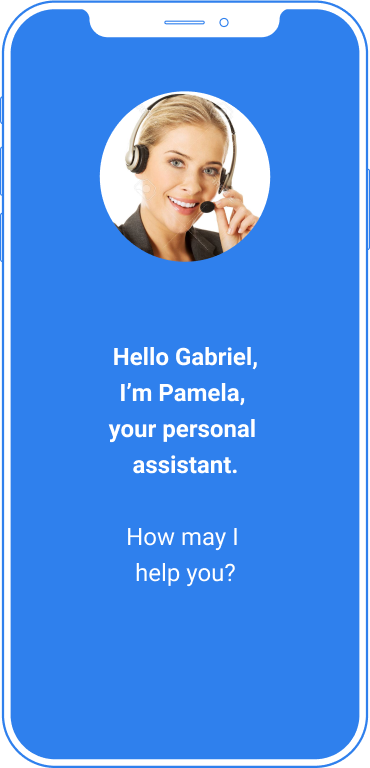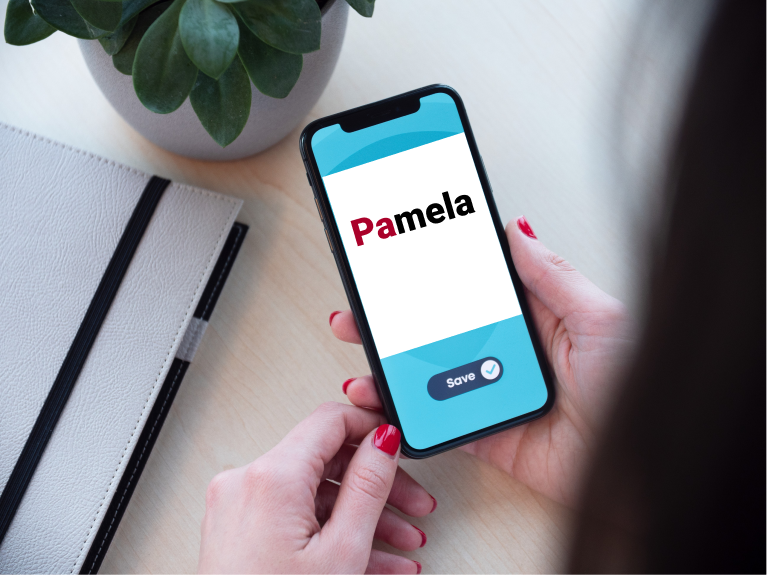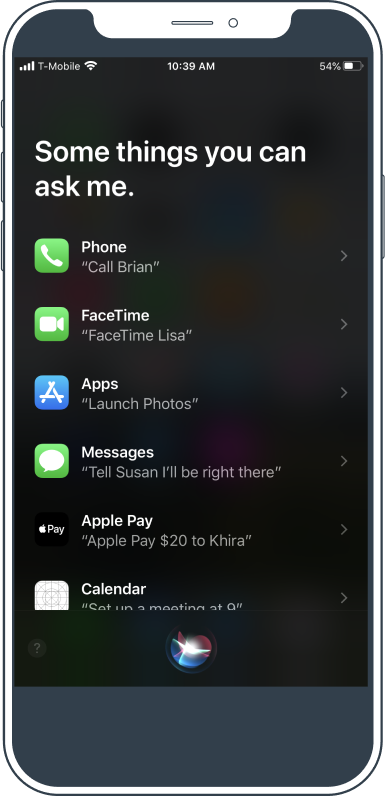Nokia
Pamela
Have more time for fun
UX Design
Research Process
//Case study

01 Discovery
02 Design
03 Delivery
01.
02.
03.
04.
05.
06.
07.
08.
09.
10.
Project overview
Project objective
Scope of work
Problem statement
Challenge
My role/team/tools
Methodology used
Project outcome
Conclusion
user/business/design/tech
The target audience is busy people of all ages and walks who need personal assistance to manage daily personal chores, and other activities, in order to make their life easier, and give them more time for fun, enjoying life with friends and families.
Business requirements: stakeholders/SMEs
Starting with the UX discovery phase, and continuig with design thinking sessions, journey mapping, wireframing/ prototyping, we delivered a proof of concept for the MVP.
Many competitive apps in the market, doing similar things. Room for a smaller “boutiqy-nishe” market.
Create an app user interface that will be easy to use, have a clean, uncluttered look and feel, using the best UX/UI practices.
Using latest technology advancements in Artificial Intelligence and Machine Learning, to deliver the best user experience.

The company, which sold its mobile division to Microsoft for $8.4 billion, might also receive warnings from Redmond to not compete with Cortana. Microsoft is reportedly already annoyed at Nokia making mobile moves, and launching a personal assistant may be a step too far.
There also has been some discussion about the “sexism” of all these new AI assistants. While default female voices can be changed to male, the obvious “girl name” naming conventions have been attracting attention, with Nokia’s Pamela and especially Amazon’s Alexa.
Possible solutions
Nokia might be the company to come up with an AI virtual assistant app, although it doesn’t have the same breadth of artificial intelligence knowledge that Google and Microsoft have acquired.
AI allows workflows to become dynamic, as they adapt in real time to all contextual information. Pockets of flexibility in the workflow take the next best action — depending on the service, network, and customer-specific conditions. In short, the customer spends less time in the conversation and has a higher degree of success upon his or her first contact.
It prevents technical support calls and leads to an always-up-and-running service experience.
Problem statement
How might we create a stand-alone virtual personal assistant voice-based app by using Artificial Intelligence and Machine Learning in a more humanized way?

Tools used: Figma, Sketch, InVision, Mural.
— Product Profile
— Key objectives
— Overall strategy
— Bottom line
— Market advantage
— Marketing profile
— SWOT analysis
— Usability (pros/cons)
— Layout:UI (pros/cons)
— Navigation (pros/cons)
— Differentiation
— Compatibility
— Calls to action
Major players

Google Assistant

Amazon Alexa
Stand-alone apps

Samsung Bixbi

Apple Siri
Samsung and Apple are dedicated to updating and improving their digital assistants, so they upgrade Bixby and Siri regularly to accommodate new features. (Lifewire)
Bixby
— Unique Bixby button on mobile devices engages with assistant.
— Bixby button functions can be remapped to other apps.
— Features a selfie shortcut.
— Executes a variety of smartphone functions, such as setting wallpaper.
— Works well with third-party apps.
— Can show up as a pop-up.
— Send files and documents to print.
— Multiple language support.
— Samsung electronic gadgets support Bixby.
Siri
— Supports shortcut voice commands.
— Siri is supported on MacBooks.
— Works well with languages and translations.
— Offers detailed weather information.
— Delivers breaking news.
— Good at sending messages and emails.
— Because it’s web based, may offer a web search instead of an answer.
— Works with the Apple HomePod and third-party smart speakers.

Samsung Bixbi
— Product Profile
debut on the Samsung Galaxy S8, but it is
designed to work across a
range of Samsung products and it is
incorporated in numerous other devices
like Samsung's Family Hub fridge
and TVs.
information (about the weather,
reminders of meetings, news articles,
and so on), learn more about what it
sees with the camera (like where to
buy a couch in the camera view), and
complete actions (such as call your
Mum for you). Bixby can learn
individual voices, so it will
personalise answers depending
on who asks.
evolves, and adapts" to you.
Bixby is also available on some
third-party apps.


— Personalized customizable experience
— Hands-free, voice activated
— Natural language recognition
— Built by Samsung
— Uses AI/ML to challenge the status quo
— Contextual awareness
— Not available on any smart speakers
— Onboarding learning curve
— Command selections list is overwhelming
— Not fully integrated with other devices
— Niche market
— Boutique-like product
— Advanced AI/ML
— Income generation marketing
— Heavy competition from major players: Google Assistant and Amazon Alexa
— Market overly saturated with voice assistants
— Usability (pros/cons)
It has a cool feature that lets you identify landmarks and other visuals by taking a photo.
You can also translate foreign languages using Bixby, or point your camera at something you want to buy and it will give you pricing options.
It will recommend businesses and restaurants, or create reminders and manage your schedule.
Apple Siri
— Product Profile
part of Apple Inc.'s iOS, iPadOS,
watchOS, macOS, and tvOS
operating systems, as well as
the Unity Game Engine.
events, setting reminders,
setting timers, and even
booking reservations at your
favorite restaurants. In fact,
Siri extends a lot of the
functionality of the iPad to
your voice, including the
ability to skip typing on
the keyboard and take voice
dictation instead.


— Personalized customizable experience
— Hands-free, voice activated
— Natural language recognition
— Built by Samsung
— Uses AI/ML to challenge the status quo
— Contextual awareness
— Not available on any smart speakers
— Onboarding learning curve
— Command selections list is overwhelming
— Not fully integrated with other devices
— Niche market
— Boutique-like product
— Advanced AI/ML
— Income generation marketing
— Heavy competition from major players: Google Assistant and Amazon Alexa
— Market overly saturated with voice assistants

— Compatibility
— iPhone 6s and later
— Second-generation AirPods (iPhone, iPad or Apple Watch connection required)
— 5th-generation iPad and later
— All iPad Pro models except the first-generation 12.9-inch model
— 5th-generation iPad mini
— 3rd-generation iPad Air
— All Apple Watch models
— HomePod
— MacBook Pro
— MacBook Air
— iMac Pro
These 3 personas are based on 6 user interviews conducted earlier, and done remotely and moderated.

Singer/entertainer
– 29 years old
– Lives in New York
– Loves music, show business, traveling, music writing, dining out
“Between traveling and touring with the band, rehearsing sessions, and publicity taping, I have very limited time for taking care of personal matters/ daily chores.”
– Needs a personal assistant she can use on daily basis for tasks outside her work
– Streamline her daily activities, so she can have more free time, and enjoy the simple things in life
– Balance work and personal life
– Make more time for friends and family
– Dedicate time for social media/fans
pain points
– Not having enough time for doing simpler things
– Being overwhelmed with work
– Neglecting family/friends
– Spending too many hours with work
– Singing rehearsals
– Meeting with the band
– Social media/promoting the music
– Work out at the gym
– Run in the park
usage
– iPhone
– Macbook Air
– iPad
– Safari/Chrome: social media websites, marketing and fitness training apps

Financial advisor
– 37 years old
– Lives in New York
– Loves European traveling, Italian food, sailboating, and reading
“Most of my time is spent working, and interacting with high-end financial clients. I would love to have a vitual personal assistant at the tip of my fingers, that can make personal appointments, reply to my email messages, and remind me of daily chores, among other things.”
– Needs a personal assistant he can use on daily basis for simple personal tasks
– An app that is easy to use, and require minimum onboarding
– Make more time for friends and family
– Enjoy hobbies, like sailing, and world traveling
pain points
– Not having enough time for doing simpler things
– Spending too many hours with work
– Missing personal appointments
– Singing rehearsals
– Meeting with the band
– Social media/promoting the music
– Work out at the gym
– Run in the park
usage
– iPhone
– Macbook Air
– iPad
– Safari/Chrome: social media websites, marketing and fitness training apps

Interior designer,
business owner
– 42 years old
– Lives in Paris,
– Loves art, museums, traveling, history, and her Burmese cat
“I wish there was an app out there that can take care of my perdonasl life, by conducting every day tasks and reminding me of personal appointments, something simpler and more dedicated than overwhelming apps like Google and Alexa”
– Needs a virtual assistant to attract more clients, send and receive email messages
– Review competitive business offering Interior Design products and services
– Make her job easier
– Make more time for friends and family
– Travel more often
pain points
– Spending too much time with having to take care of small tasks
– Designing patterns for clients
– Delegating work to employees
– Social media/promoting the music
– Work out at the gym
usage
– iPhone
– Macbook Air
– iPad
– Safari/Chrome: social media websites, marketing and fitness training apps